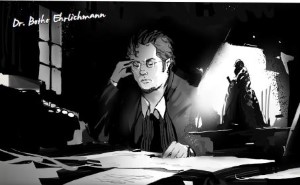
Dr. Botho Ehrlichmann’s Black Stone Journal |
. |
 |
in German, Botho Ehrlichmann, unpublished c.1938-1939.
Information gained from a full study (2 weeks)
Written in Ehrlichmann’s own hand, the journal contains fresh translations of the Black Stone discovered by the DOG at Saïs before the Great War, as well as the archaeologist’s own research notes regarding his discoveries about the Palladion.
Upon close inspection it can be seen that the journal is split into sections, the first of which is Ehrlichmann’s justification for carrying out the research. After this comes what appears to be a long and rambling story which takes up several pages, marked as “Burgdorf’s Translation”. The next section appears to be a repeat of the one before it, but certain areas are heavily underlined in red ink. At the end of that section are notes pertaining to the highlighted stretches of text, which seem to suggest that there was something flawed in the original translation carried out by Prof. Burgdorf.
After that come five more sections, each headed with a small snippet of the translated story from before. Beneath the quoted text are Ehrlichmann’s conjectures as to what the clues mean and a variety of sketches, plans, questions, and surmises based on his personal research. There are diagrams of strange-looking pyramids, odd statues (one resembling the statue from Pinzolo), and something which looks very like the Rosetta Stone, amongst many others. Against this last – labelled “the Black Stone” – is a note saying “In the basement, Museum of Antiquities, Cairo”. Nearby is a scribbled name; “Major Aloysius Blythe-Manders” followed by “Cairo?”
Tellingly, towards the rear of the journal, there are notes on his meetings with his Nachtwölfe inquisitors. They are very brief, but full of misgivings and foreboding. It’s clear that he allowed them to continue to believe that the Stone no longer existed. The final sentence reads: “I have given them only Burgdorf’s translation as my own. Something in their questioning bothers me greatly, and I can always plead ignorance should the old man’s work prove to be as flawed in certain areas as I suspect.”
Stuffed into the leaves at the back of the book is a separate, partial rubbing of the Black Stone itself, close to something that resembles a grammar key. Egyptian hieroglyphics are written down next to the strange, runic script from the bottom section of the Black Stone, with German translations next to them. 15 hours study (requiring either Egyptian or German language skill) will allow a reader to digest this piece of work. If the rubbing were complete, or the stone itself available, the results would be better.
This script is the same as that on the Statue and the three pages of The Book of the Machine.
.